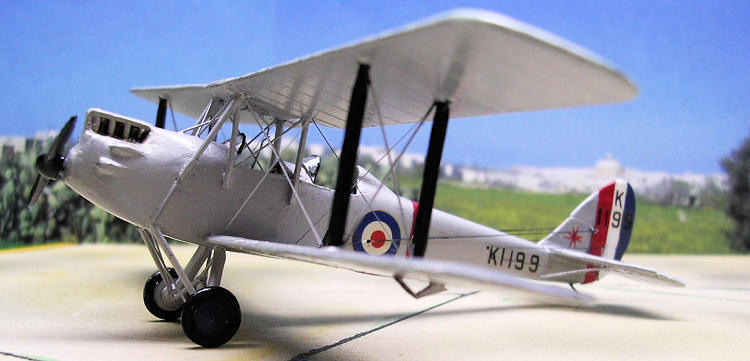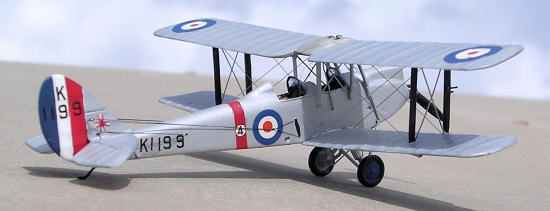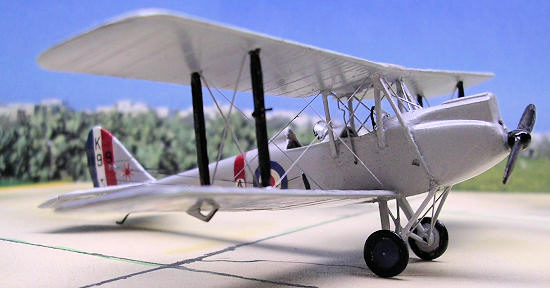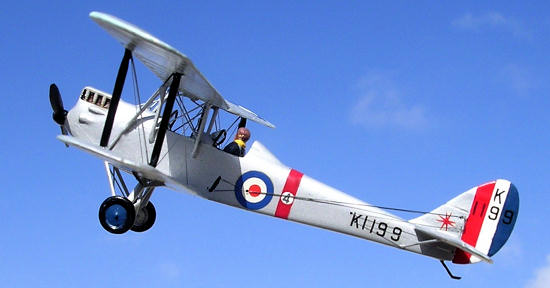
Frog 1/72 DH-60M
| KIT #: | ? |
| PRICE: | $? |
| DECALS: | None supplied |
| REVIEWER: | Carmel J. Attard |
| NOTES: |
Russian
company ex Frog |

| HISTORY |
During the late 20s
bush-flying requirements overseas has given rise for De Havilland Company to
introduce a strengthened version of the Gipsy Moth. The type was designated
DH60M Moth and was built around a fabric covered, welded steel tube which
eliminated the easily damaged wooden structure. The variant had a number of
prominent stringers along the fuselage sides,
 which
served as its identifying feature. The metal fuselage imposed a weight penalty
of 62 lbs. The fabric cover offered the advantage of ease of inspection and
maintenance interior and holes were cheaply repairable with a simple doped
patch. The DH60M attracted immediate orders from Air Forces of
which
served as its identifying feature. The metal fuselage imposed a weight penalty
of 62 lbs. The fabric cover offered the advantage of ease of inspection and
maintenance interior and holes were cheaply repairable with a simple doped
patch. The DH60M attracted immediate orders from Air Forces of
Moths K1198 and K1199 went to Hal Far
Miscellaneous Flight, in
| THE KIT |
 The
Gipsy Moth kit was received from
The
Gipsy Moth kit was received from
| CONSTRUCTION |
The exploded view
given on the instruction was adequate. The parts need carefully cleaning up
before putting together. There is some surface detail and where possible should be preserved. Assembly should be a reasonably simple job once
the excess flush has been removed from every kit part. The sharp corners of the
fuselage rear were rounded as best one could to simulate the re-designed steel
tube structure of the ‘M’ version. We then could start detailing the two open
cockpits. This included adding the forward and aft instrument panels, side
fittings, control stick, rudder pedals, and compass, seat straps and paint
detail. Tiny holes were drilled at proper places on sides of rear fuselage to
take the control lines for the rudder and elevators. Two windshields were also
drawn and fashioned from clear acetate to fit at a later stage. Cockpit openings
had the corners shaped square to conform to that on K1199 (4) photo that I was
working on. A raised fairing was built up and shaped on aft fuselage at the rear
of the hind crew seat. Exhaust pipes were also modified to suit. Fuel supply
pipe work was added. This was located under the central wing section in front of
the cockpit. Small control horns were added to the flying surfaces that were
fashioned from plastic stock. In the end a fuel tank filler cup and rudder
control cables were added. This and proper rigging were made from thin clear
nylon thread.
possible should be preserved. Assembly should be a reasonably simple job once
the excess flush has been removed from every kit part. The sharp corners of the
fuselage rear were rounded as best one could to simulate the re-designed steel
tube structure of the ‘M’ version. We then could start detailing the two open
cockpits. This included adding the forward and aft instrument panels, side
fittings, control stick, rudder pedals, and compass, seat straps and paint
detail. Tiny holes were drilled at proper places on sides of rear fuselage to
take the control lines for the rudder and elevators. Two windshields were also
drawn and fashioned from clear acetate to fit at a later stage. Cockpit openings
had the corners shaped square to conform to that on K1199 (4) photo that I was
working on. A raised fairing was built up and shaped on aft fuselage at the rear
of the hind crew seat. Exhaust pipes were also modified to suit. Fuel supply
pipe work was added. This was located under the central wing section in front of
the cockpit. Small control horns were added to the flying surfaces that were
fashioned from plastic stock. In the end a fuel tank filler cup and rudder
control cables were added. This and proper rigging were made from thin clear
nylon thread.
| COLORS & MARKINGS |
 Reference
was made to a clear photo of the DH 60M Moth K11999 (M) that was located on
P.144 of ‘Military Aviation in
Reference
was made to a clear photo of the DH 60M Moth K11999 (M) that was located on
P.144 of ‘Military Aviation in
| CONCLUSIONS |
The DH60M was
completed in a local livery (Maltese) that made it one of the most interesting
aircraft found in a local collection since it was a very common sight in those
early years making frequent flight allover the island. For further analysis of
variations in colourschemes applied to RAF Station DH60M Moths one can refer to
an article located on the October 1978 Volume 6 No10 issue of Aeroplane Monthly.
| REFERENCES |
Aeroplane Monthly.
Volume 6 No 10
Military Aviation in
June 2010
If you would like your product reviewed fairly and quickly, please contact me or see other details in the Note to Contributors.